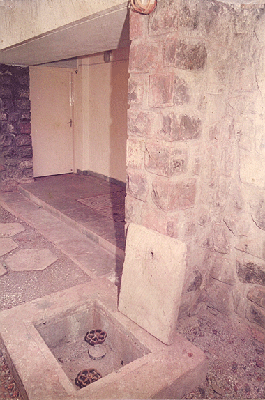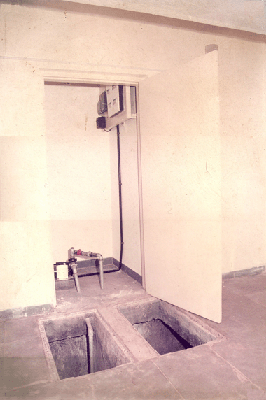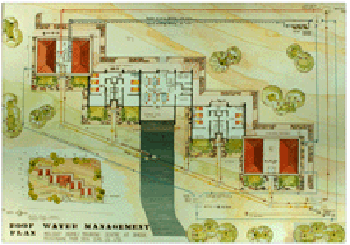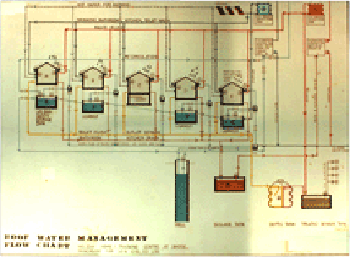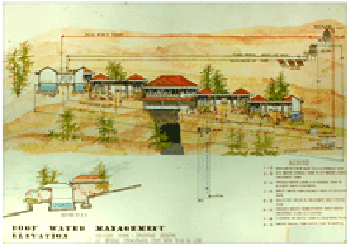Rain Water Harvesting Projects - Ion Exchange
Introduction :
There has been increasing awareness of the interaction between the man and his environment. The natural result of this has been maximizing use of natural resources with simultaneous protection and enhancing the environment. The air, land and water are the three principal components of our environment. Water occupies the vital position in the environmental resources. Management of environmental resources involve many disciplines. However, as an Architect, I thought of putting the water from roof top which is usually lost as run off, to its optimum use for better environment. All life on the earth is interdependent in one way or the other on water. In fact less than 4% of the total water on the earth can be used for human consumption which makes it imperative to study the quality of water on the earth & also its occurrence, distribution, quantity, storage, its harvesting and management.
The monsoon lasts only for the period of four months. If the rain water curing this period is collected and stored, it can be supplied for the consumption not only during the monsoon, but also throughout the year.
Area Of Implementation :
This project consist of Holiday Home/Training Centre for Ion Exchange (I) Ltd. located at village Bhose, Panchgani, Tal. Mahabaleshwar, Maharashtra. The plot area is about 4325.30sq.mtrs. And the built up area is about 817.00 sq.mtrs.
Pre Scenario :
Although Bhose Village near Panchgani gets annual rain fall around 6223 mm. maximum in Maharashtra, being on one of the peaks of Sahyadri ranges in western Maharashtra, there is no catchment. The rain water, therefore literally falls on steep slopes of the hills & gushes down to the base of the hill in river Krishna. Thus this picturesque hill top faces recurring water shortages after monsoon, specially during the summer season, when the tourist season is at its peak.
Since between Panchagani & Mahabaleshwar on a peak of hill away from urban development there was NO WATER & ELECTRICITY. Many villages down the line had wells but even those wells use to dry during March, April, May & till mid of June till monsoon arrives. Thus Govt. use to supply water by tankers to these villages.

Work Implementation :
This project consist of Holiday Home/Training Centre accommodating nearly thirty persons in eight suites, training hall, kitchen-dining lounge facilities. The structure is designed in R.C.C. with sloping roof channels collecting rain water from roof, with brick walls cladded with stone. Each unit is consisting of two guest rooms and attached toilets. The building is so designed to take maximum advantage of the panoramic view and gushing cool wind with maximum wide openings towards west, at the same time, levels are so designed that the privacy is maintained inside the rooms, as well as stored water from tanks and also treated water flow with gravity without any mechanical means by using the site levels to its maximum advantage by doing minimum cutting and filling.
Process - 1 :
In this project the water is collected during the monsoon from roof channels through down take pipes. Before taking the water into the tanks, it is filtered and then allowed to enter in to the basement. For first seven days of the monsoon, the rain water is not taken into the tank as it cleans the roof. The said water is allowed to drain off the hill slopes. After cleaning of the roof, water is allowed to enter into the basement tanks which takes about seven to fifteen days to fill these under ground primary water storage tanks. The capacity of the tanks are worked out considering the occupancy all throughout the year.
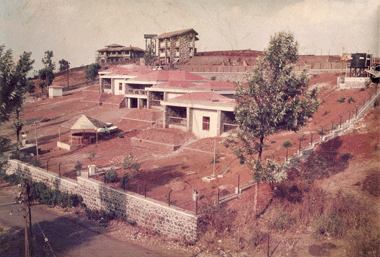
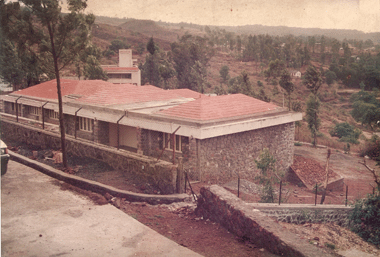
Process - 2 :
The water from these primary tanks is used for consumption, bathing and for cooking and also hot water with the help of solar energy.
Process - 3 :
The used bath and kitchen water is collected again in secondary tank, filtered & reused in toilets for flushing.
Process - 4 :
The used toilet water is again collected in tertiary tank and filtered and used for gardening.
Process - 5 :
The water surplus after filling the underground tanks, which is put into the well, can be used after treatment for special purposes like swimming pool, landscaping or even for use of additional people. MOREOVER SINCE THE WATER TABLE IN THIS VICINITY INCREASED, THE SURROUNDING NEIGHBOURHOOD VILLAGE STARTED GETTING WATER TO THEIR WELLS EVEN SUMMER MONTHS OF MARCH, APRIL, MAY WAS THE REAL ACHIEVEMENT.
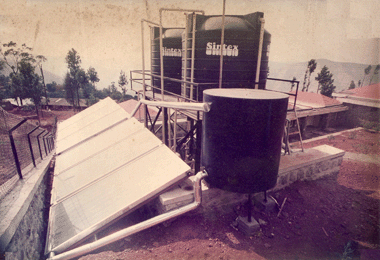
Post Scenario :
It has set an example motivated everybody to rejuvenate the old concept of storing rain water in the basement of structure. Recycle, recover, reduce / conserve the water and by minimizing discharges to control the pollution. Water recycling has reduce the requirement of fresh water by nearly 60% . It is easy to implement and provides an insurance against water scarcity and conserve precious water resource and protect the environment.
In this project the water is collected during the monsoon from roof and stored in the basement/under ground primary water storage tanks which are filled in first three weeks, to next three months it is stored, percolated in a charging well on hill top. The capacity of the tanks are worked out considering the occupancy all throughout the year. The water from these primary tanks is used for consumption, bathing and for cooking and also hot water with the help of solar energy. The used bath and kitchen water is collected again in secondary tank, filtered reused in toilets for flushing. The used toilet water is again collected in tertiary tank and filtered and used for gardening. Thus the water is recycled thrice, which minimizes the water requirement by almost 60%, helps in keeping the size of the under ground tanks smaller, in proportion to the entire structure, by maximizing the use of structural foundation components in the form of basement/ underground tanks.
Using roof water minimizes the chances of water getting polluted as it happens in normal system and thus stops any dangerous deceases spread or epidemics. It is like every house having its own well in its compound. This stored water is also useful during the emergencies like outbreaks of fire, wars i.e. when municipal water supply is in danger of being cut-off, which was observed in Iraq, Israel recently
Special Feature :
Normally, hill acts as a huge sponge, which stores the rain water in the monsoon and gives away this water in other seasons. If this water runs off swiftly over steep slopes and does not percolate in the hill mass, it is of no use. But after filling of basements if it is stopped, stored and allowed to percolate in the soil mass through charging well effectively in the monsoon, then the same water is used in the remaining seasons very effectively for other purposes.
Inputs & Outputs :
This concept is used effectively in this project, by channelizing the over flow of roof water after filling the tanks into the newly dug well for more than three months, which charged the entire hill mass with the water and thus increased the water table in the vicinity.
Cost Benefits :
On the hill top, Costliest picturous land which was non developable is made developable, which has increased the land cost of this plot and also of plots around which is in many folds compared to actual cost. The cost of harvesting Tanks is one time investment. THE BEST PART IS SUPPLY OF TANKER WATER COST IS SAVED OF WHICH VALUE IS UNCOUNTABLE
SUSTAINABITY
The 'SANSKRIT SHLOKA' says,
The 'SANSKRIT SHLOKA1 says,
Which means the way mother feeds milk to her child, these hills of mother earth feeds water to human beings, in scientific language this hills soak water like sponge in the monsoon for four months and give away the soaked water for remaining eight months and quench the thrust of humans, animals, nature.
Scope of Replication :
All these concepts mentioned above can also be used effectively in the cities, where the water is scarce or the existing water can be used for additional population/industries which brings golden equilibrium or balance of development and its environment
Awareness Generated :
This work was Awarded by JIIA for excalance in Architecture. Many Architects used this theme all through out India and abroad. I have lectured more than 300 places including T. V., Radio, Colleges, LIT. School etc. lakhs of people are now aware of this.
